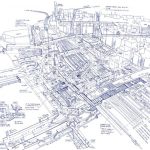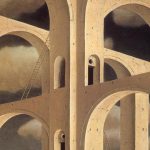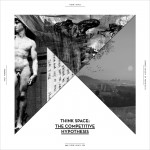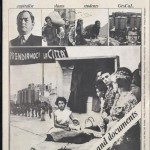In 1970 Japanese architect Minoru Takeyama designed a building in Shinjuku-ku, Tokyo, simply called the Ni-Ban-Kahn (Building Number Two), while his Building Number One was located just a few metres away. This building gained wide notoriety thanks to American critic Charles Jencks, who put it on different editions of the cover of his seminal The Language of Post-Modern Architecture, originally published in 1977.

Ni-Ban-Kahn is formed by several volumes growing from a common platform, a composition conceived in order to achieve the maximal density allowed by the lot. Some feature a horizontal roof while others are covered with a single roof. The combination of volumes reflects the chaotic nature of Tokyo’s built environment and react differently to the various built situations around this corner of the city. The focus on the volumes and the geometric richness are paired with an extremely inventive graphical work by Kiyoshi Awazu composed by patterns, optical lines, commercial and written signs, making the complex an interesting example of commercial and leisure facility designed with the codes of “intellectual” architecture in mind. Jencks wrote that the building deserved to be put on the cover for its being “a radical expression of functional difference and more for its social realism than its uplift (…) Moreover, it was the most vivid, built example of Venturi’s contradiction in architecture“. (Quote via)
The outside street enters the ground floor without any gates or doors: the interior space of the building is, in fact, in continuity with the public space of the city of Tokyo.
The building was commissioned by a Korean client with the aim of realizing a centre for entertainment made up of many different interior functions and rented out to multiple tenants. Multifunctionality and perennial adaptability are thus taken into account since the beginning of the design process and even the façades often changed their graphical patterns over time: although they were mostly colored at the beginning, they are black and white, nowadays. Also, the functions evolved rapidly and while the area was still, at the time of construction, mostly residential, today is part of Kabukichō, the red-light and entertainment district. Not by chance, the building houses as of today (2016) a series of male host clubs largely advertised on the envelope.







The building in its current state. Photo by M. Fabrizi – Socks – 2016
All images © Minoru Takeyama
Further reading
Charles Jencks, Language of Post-Modern Architecture, London: Academy Editions, 1977; New York: Rizzoli, 1977. Excerpt.




“Built example of Venturi’s C&C” you say and reference Jencks’ book.
Here’s some ancient history: my review of Jencks in Building Design (UK), May 1977 – 39 years ago.
SURELY we have suffered enough under the yoke of puritanical morals in architecture.
Now, 130 years after Pugin so subtly and insidiously muddled pleasant architecture and honest behaviour, a century after Ruskin confirmed this poisonous confusion of beauty and morality, at last we are fighting free. And, as we sense with embarrassment, we now realise that the architect-designed environment has been thinned out and simplified — literally, in terms of planes, materials, mouldings, colours — but, more, it has been reduced in richness of meaning over this century.
It has thus lost its power of appeal but, rather more than that, it has quite clearly been communicating meanings very different from the designers’ usually vague intentions. Now enter Mr Jencks.
Charles Jencks is a lively writer with the knack of flogging dead horses in an original way and with an easy and jaunty style. “Modern architecture,” I quote, “died in St Louis, Missouri on July 15, 1.972 at 3.32 pm when the infamous Pruitt-Igoe scheme . . . was finally put out of its misery. Boom boom boom.” Colour supplement stuff, with “confection” the commonest synonym for “building” throughout.
The first third of this short essay is, as he says, a romp through the desolation of modern architecture. He isolates the univalent and unambiguous tendencies in the Modern Movement style, and how the public has interpreted it. The second section, half the book, enlarges on this theme of architecture as communication.
Here is sketched, not very coherently, a linguistic analogy, with most space given to the way buildings inevitably are seen as metaphors for other objects, what might be called an unintended associationism. Architects leave to intuition the questions of how their buildings “speak” if they acknowledge them at all, he argues, and this is the crucial communication gap.
Then the third section, the final 14 pages, discusses the unhappy, if journalistically cute, title, “post-modern architecture”. The hopeful signs of a more mixed, rich architecture, able to carry its traditions lightly, while keeping coyness, and on the other hand irony, in check.
As a theory or a critique, all three — the debunking, the ways of reading buildings, and the delineation of a new “postmodern” group — are certainly light. But, if superficial, it is an attractive surface to slide easily across, and on the way we are exposed to a startling variety of images. (The book is lavishly illustrated, and with a central colour supplement and A4 format gives good value for money.)
Happily semiology is kept in check, but it’s a pity not even to give a nod to old Ledoux who, after all, did discuss this idea of architecture parlante, nor even to mention Venturi’s concept of contradiction and complexity, of “both/and” which is central to the Jencks post-modern theme.
The tale of the changing visual intentions of modern architecture — that is over the nearly two centuries since the breakdown of a coherent style and the rise both of associationism and of moral stances — does need to be told in a straightforward way.
It may then be seen that the interesting experiments with style today, what Jencks hails as a new art nouveau, is nearer a new picturesque, taking off where the moralists fogged the picture; both in its acceptance of playfulness in the use of associational images, and in its rejection of a moralist stance, of that terribly serious Ruskinian-through-Bauhaus tradition of the honestly expressed plan, honestly expressed structure, honestly used materials.
Jencks rightly admires recent attempts to increase the richness of meaning in architecture, but he doesn’t quite get round to the realisation that this, viewed in terms of an architectural history rather wider than the Modern Movement, is simply saying that good architects are better than dull ones; that the more there is there, the more allusive the images, symbols, forms, then the more we get out of it.
He looks at Graves’ and Eisenman’s games with Corb’s syntax, at Kikutake’s mixing tradition and modern imagery, at Charles Moore and Venturi’s intellectual awareness of signs, at Lucien Kroll’s ad-hoc collaged, timeless facades, and finally, as if to show up the tortuousness of forcing a good argument into the threadbare post-modern portmanteau, he ends with Antoni Gaudi, “the only architect really using a pluralist language to produce multivalent works.”
Is Jencks really laughing up his own argument when he concludes: “A realistic assessment of the situation suggests that schizophrenia is the only intelligent approach. The architect should be trained as a radical schizophrenic (everything must be radical today)…”
Chic nonsense like this, however, must not be allowed to hide the optimistic argument which is seldom enough put: “We must go back to a point where architects took responsibility for rhetoric, for how buildings communicated intentionally, how ‘decorum’ and bienseance were consciously achieved . . . The jobs that too often take up his energy might be better done by engineers and sociologists, but no other profession is specifically responsible for articulating meaning and seeing that the environment is sensual, humourous, surprising and coded as a readable text. This is the architect’s job and pleasure, not, let us hope, ever again his problem.”
With these positive introductory remarks, Jencks ends; for that tale remains to be told.
John McKean, Buildinbg Design 27 May 1977 (Jencks replied the following week)